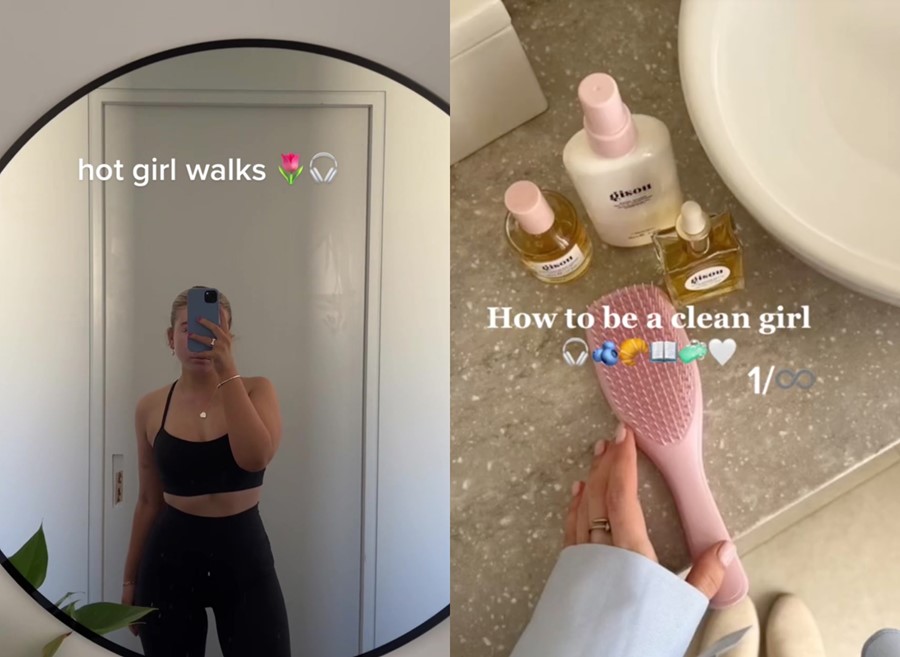Sad girl music, hot girl walks, feral girl summer, girl dinner and now girl math: why do we keep girlifying everything?
The word ‘girl’ is all across the internet right now, from ‘sad girl music’ to ‘feral girl lit’, or ‘hot girl walks’ to ‘rat girl summer’. At this point, ‘girl’ trends have snowballed into a fully-fledged girl avalanche, and we’re increasingly using the term to describe every little activity in our lives, no matter how mundane. In the space of just a few months, we’ve seen ‘girl dinner’, which, as Nigella Lawson pointed out, is really just picky bits; ‘girl math’, in which poor logic is used to make excuses for extravagant spending; ‘lazy girl jobs’, which are basically bullshit jobs, and bizarrely, ‘girl beer’, which is just a recipe for a frozen lager shandy. There’s also a number of made-up ‘girl’ fashion and beauty microtrends – maybe you’re a “strawberry girl”? Or a “vanilla girl”? Or a “tomato girl”? Or a “coconut girl”? Or a “clean girl”?
Most of the people engaging with ‘girl’ content are women – not girls. Which begs the question: why are so many of us embracing this infantilisation? And are these trends reinforcing old-fashioned gender codes which trivialise women’s experiences?
Maybe all this ‘girl’ talk is all entirely meaningless – or maybe it’s actually a good thing, and we’re reclaiming the word ‘girl’ in a similar way to how we’ve reclaimed ‘bimbo’ or ‘bitch’. Last year Nana Baah wrote in Refinery29 that the rise of the term ‘girlie’ “is infantilising in a way that feels completely disconnected from misogyny”, even going as far as to state that everyone is a girlie, regardless of gender.
But I’m not sure if we really can embrace or reclaim ‘girliness’ in this way, when so many of these trends reinforce harmful, essentialising ideas. For example, take the ‘girl dinner’ trend, which romanticises as the lazy meals that ‘girls’ make. The subtext underpinning the trend is that women can’t be lazy, unless it’s combined with a cutesy performative dig at their failed domesticity. In the case of the more problematic videos – where someone‘s ‘girl dinner’ comprises a Diet Coke and a vape – the trend seems to imply that disordered eating is a solely female issue, and that women should be preoccupied with being thin.
The internet’s determination to use this trend for everything was bound to return to subjects that contained a history of gendered prejudice too. For example, ‘girl beer’ evokes the misogynistic stereotype that women don’t really like beer, that it’s ‘too much’ for our delicate palettes. ‘Girl math’ implies that women make stupid financial decisions, and it’s men who are naturally better at being logical.
@elevateyourboutique Girl dinner to the extreme #girldinner #girldinners #girldinnersong ♬ original sound - karma carr
Plus, these trends do nothing to challenge the longstanding, historical dismissal of women’s interests. Take the ‘sad girl novel’, which began as a literary trend due to the popularity of certain books like Ottessa Moshfegh’s A Year of Rest and Relaxation, Elif Batuman’s The Idiot and Sally Rooney’s oeuvre. As Ash Sarkar pointed out in a piece for GQ, in the 19th century reading a novel was dismissed as a frivolous, feminised leisure activity. So, really, is it a good thing to categorise these sorts of books – which, by the way, have depth and tackle important themes and are good – as ‘sad girl lit’ and perpetuate the trivialising of women’s interests and issues?
The ‘girl’ trend not only trivialises women’s interests, but also women’s suffering. There are over 883 million TikToks showing users taking themselves on ‘hot girl walks’ for their mental health. This is largely a continuation of the individual responsibility placed on us to take care of our mental health that was popular on Instagram in the 2010s, with posts explaining boring self-care tasks – content which, again, was aimed primarily at women. It’s not to say that any of these practices don’t help, but it’s another trend which puts the onus on us rather than highlighting that our well-being is a societal issue. We need accessible therapy and mental health services more than we need to take ourselves for a hot girl walk.
Of course, it’s worth acknowledging that almost none of the users that hop on board these trends intend in undermining their fellow girlies. But still, the subtext is clear: young women are really ‘girls’, and girls aren’t to be taken seriously.
So why are we still so set on referring to ourselves and our lifestyle choices as ‘girl’ trends? It feels more than just an attempt to reclaim girliness – it almost feels like a refusal to grow up. We would rather refer to ourselves as “twenty something year old teenage girls“ than women, suggesting that we’re almost experiencing a stunted youth, which is probably, as we all know by now, down to this strange new era of late-stage capitalism. After all, very few of us can now take the next step into adult life, whether that be renting a place alone or getting a mortgage. It’s not surprising then that we feel trapped as ‘girls’.
But we should try to resist this girlification and the trivialisation of women‘s interests and experiences. As Ursula K Le Guin famously said, “why should women keep talking baby talk while men get to grow up? Why should women feel blindly while men get to think?”. Ultimately, we do more to reclaim girlhood by embracing being women who contain complex messy multitudes – instead of hiding behind childishness.
Join Dazed Club and be part of our world! You get exclusive access to events, parties, festivals and our editors, as well as a free subscription to Dazed for a year. Join for £5/month today.




